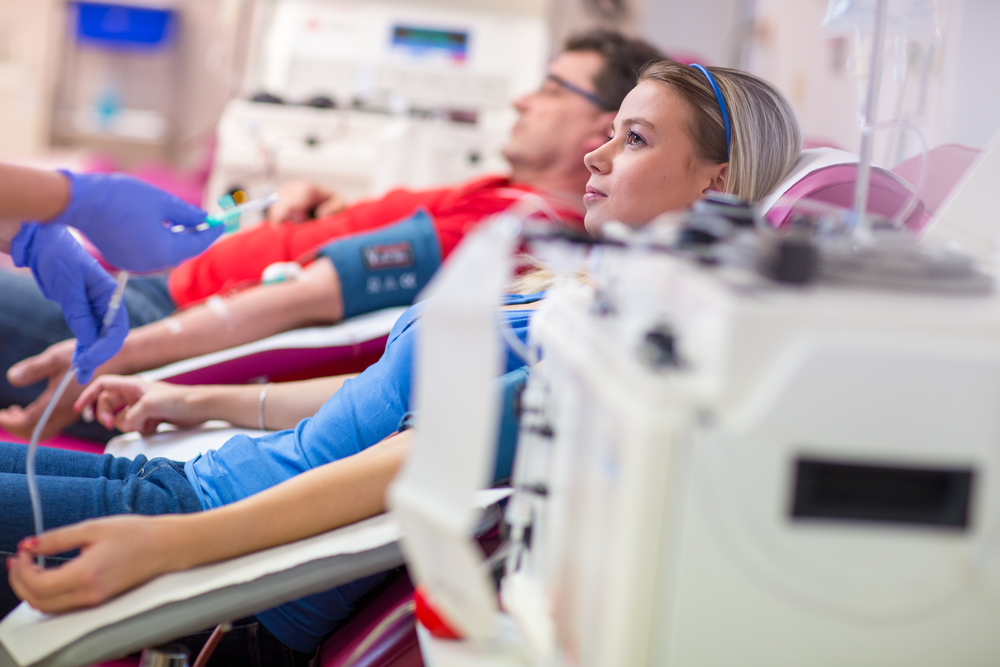If you're thinking about donating your plasma for extra money, you're in good company. Over 16 million people in the US donate their plasma every year.
Because of its life-saving qualities, there's always a strong demand for human plasma, which is why you might get top dollar for your donation.
But as with most things, not all donation centers are created equal.
To make sure you get the most money for your plasma, we've researched the best plasma donation centers and only picked those who pay the most for plasma.
We also verified that they’re safe, FDA-approved, and actually pay their donors properly and on time.
Don't take plasma donation lightly—use our recommendations to get the most value for your time without compromising your health.
You can multiply how much you earn by making money from these apps while donating plasma:
- MobileXpression: A passive income earner – MobileXpression will pay you just to keep the app installed on your phone.
- Inbox Dollars: Check this app regularly as they have many earning opportunities that show up every day. They even pay you $5 to sign up.
- Mistplay: A really fun way to earn money – you get paid just to play mobile games.
How does plasma donation work?
To donate plasma, you'll head to a local plasma donation center, where professionals will draw your blood, separate the plasma from the red blood cells, and then return the rest of your blood back into your body.
It usually takes 45 minutes to two hours to donate plasma. Each donation center sets its own rates, but you can expect somewhere between $20 and $50 per visit, depending on how often you go and how much plasma they take from you (it varies based on weight).
Note:
The donation center pays you for your time, not for the actual plasma itself — the US discourages the sale of blood or blood components.
Are you qualified to donate plasma?
The requirements to donate plasma are similar to that of blood donation. Eligibility requirements vary by state and donation center, but usually, you must meet these criteria to donate:
- Be at least 18 years old; some states require donors to be 21
- Weigh at least 110 pounds
- Have a good general health
- Have valid photo identification (e.g., driver's license, state ID, school ID)
- Have had no tattoos or piercings in the last 12 months
- Have a Social Security number
- Have a permanent address (no temporary or transitional addresses)
- Test negative for hepatitis, HIV, and other transmissible viruses
- Pass a medical exam
- Complete a detailed screening for medical history

8 Plasma Donation Centers That Pay the Most in the US
Where can I find the highest-paying plasma donation center near me? I wonder… and find this button a bit handy! Just enter your zip code and see if any of the list below is near you too.
The following plasma donation centers offer some of the highest payouts for donors.
Please note that the rates vary among locations even for the same plasma center, so it’s best to contact your local donation center to confirm their latest compensation rate.
1. Grifols/Biomat US: $45 – $75 Per Donation
Grifols/Biomat USA is a subsidiary of Grifols Inc., a global manufacturer of plasma-derived medicines, founded in Barcelona, Spain.
Compensation
You can earn up to $400 per month (for regular donors) for plasma donations at Grifols/Biomat USA.
Locations
This center has nearly 100 locations, including those on the West Coast and some areas in the Deep South. It’s also one of the highest-paying plasma donation centers near Illinois and other Midwestern locations.
Find a Grifols/Biomat USA plasma center near you.
Payment Method
Prepaid debit card (check with your local center for other forms of payment)
Other Perks for Plasma Donors
- Bonuses for first-time donors
- Bonuses for regular donors
- Donor referral program
- Raffle draws
2. Kedplasma: $25 – $75 Per Donation
Kedplasma collects plasma to make therapies for patients with immune deficiencies, hemophilia, shock and trauma, and other blood-related conditions.
Compensation
You can get paid $50 for your first plasma donation, $75 for your second one, and $50 each for your next three.
Prices vary per location from the 6th donation onwards. If you’re a regular donor, you can earn up to $400 a month depending on your weight and how much each location pays.
Locations
Kedplasma has over 70 locations across the United States. It’s one of the highest-paying plasma donation centers near Alabama, Georgia, including Florida, Los Angeles, Texas, and more.
Find a Kedplasma donation center near you.
Payment Method
Prepaid debit card
Other Perks for Plasma Donors
- Wellness checkup
- KEDREWARDS program
- Referral bonuses
3. BPL Plasma: $50 Per Donation
BPL Plasma is one of the largest plasma collection companies in the U.S.
The company accepts donations from healthy individuals and uses the plasma to create life-saving therapies for patients with immunodeficiency diseases (e.g., AIDS, hypogammaglobulinemia) and hemophilia.
Compensation
Earn $50 for plasma donations and up to $400 a month.
Locations
They have multiple locations in 32 states.
Find a BPL Plasma donation center near you.
Payment Method
You can get paid via Visa prepaid card, check, PayPal, or cash.
Other Perks for Plasma Donors
- $15 bonus for your 6th plasma donation
- $80 bonus for your 8th plasma donation
- $15 for referrals
- Gift cards
4. Interstate Blood Bank: $30 – $50 Per Donation
The Interstate Blood Bank, Inc. laboratory collects human blood/human blood components for distribution to the diagnostic and therapeutic industries. In other words, it’s a blood bank that pays donors for their plasma donations as well.
Compensation
Interstate Blood Bank pays $30 to $50 per plasma donation, depending on the donor's weight.
Locations
It has several locations across the country, including Georgia, Illinois, Indiana, Michigan, North Carolina, Ohio, and Tennessee.
Find an Interstate Blood Bank location near you.
Payment Method
Cash or Paysign
Other Perks for Plasma Donors
- Loyalty program
- Redeem points for cash or gift cards
- Free wellness checkup
5. Biolife Plasma: $20 – $50 Per Donation
Biolife Plasma Services is a subsidiary of Takeda Pharmaceuticals, which is one of the largest pharmaceutical companies in the world. It offers life-saving plasma to patients who have rare and chronic diseases or disorders.
Compensation
You can earn between $20 and $50 per donation, depending on how frequently you donate and your weight.
Locations
Biolife has nearly 100 locations across the country, with most states having at least one location.
Find a Biolife Plasma donation center near you.
Payment Method
Prepaid debit MasterCard
Other Perks for Plasma Donors
- Up to $900 bonus for first-time plasma donors
- On-site playrooms for donors with kids
6. CSL Plasma: $20 – $45 Per Donation
CSL Plasma is a division of CSL Behring, a global biotherapeutics company. The company was one of the first to isolate and produce human plasma-derived protein therapies.
Compensation
The company pays up to $45 for each successful plasma donation. The exact amount it pays depends on your weight, frequency of donation, and location.
Locations
CSL Plasma has locations in several states across the US. It’s one of the highest-paying plasma donation centers in San Diego and other areas in California, Arizona, Colorado, Florida, Georgia, Idaho, Illinois, Indiana, Massachusetts, Michigan, Minnesota, and Missouri.
Find a CSL Plasma donation center near you.
Payment Method
Prepaid debit card
Other Perks for Plasma Donors
- iGive Rewards Program
- Exchange iGive points for express passes and gift cards
7. Immunotek: $20 – $30 Per Donation
Immunotek is an FDA-licensed, state-of-the-art facility dedicated to the collection of human plasma for a variety of life-saving treatments and therapies.
Compensation
Immunotek pays plasma donors up to $30 per completed donation.
Locations
Immunotek has 20+ centers across the US.
Find an Immunotek plasma donation center near you.
Payment Method
Prepaid debit card
Other Perks for Plasma Donors
- Free health screenings
8. GCAM: $25 – $30 Per Donation
GCAM Plasma collects and stores plasma for pharmaceutical companies to use in developing treatments for diseases and illnesses.
Compensation
You can get paid up to $30 for each successful plasma donation.
Locations
It operates multiple facilities across the US and is one of the highest-paying plasma donation centers in San Antonio and other areas in Texas, California, Washington, Idaho, and Indianapolis.
Find a GCAM Plasma donation center near you.
Payment Method
Cash or debit card
Other Perks for Plasma Donors
- Cash bonuses for frequent donors
- Coupons and gift cards
How Often Can You Donate Plasma?

The US Food and Drug Administration (FDA) allows 2 donations within a 7-day period, with at least 48 hours between donations.
It can take up to two days for your body to replace the fluid volume of the donated plasma.
The American Red Cross, however, recommends donating only once every 28 days or up to 13 times a year. This is because frequent donation can lower the quality of your plasma.
When Can You Not Donate Plasma?
The following conditions or situations may cause you to be deferred from donating plasma:
- Common cold or other infections (including sore throat, cough, fever)
- Vaccinations within 24 hours of donation
- Recent cosmetic procedures, including body piercings, tattoos, and permanent make-up. (Donors must wait four months after receiving a tattoo in certain states.)
- Oral or intravenous steroid use within the last two weeks (unless prescribed by a physician)
- Pregnancy and/or six weeks postpartum
- Breastfeeding women
- Cold or allergy medications containing antihistamines within two days of donation
- Communicable diseases like HIV
If any of these apply to you, the center may decline your application, but don't worry — this doesn't mean you can never donate plasma again.
With some of these disqualifiers, such as weight and low blood pressure, you just need to wait until they’re at acceptable levels before trying to donate again.
With others, like getting a new tattoo or piercing, it's only a temporary restriction that goes away after your body has healed.
Can you donate plasma when you’re pregnant?
No, you will not be permitted to donate plasma if you’re pregnant.
Pregnancy causes many changes to your body, including your blood volume. This can affect your hematocrit levels, which must be above 30% before you may donate.
Note:
- If you have had a miscarriage or abortion within the last month, you will not be able to donate.
- If you have given birth within the last six months and are breastfeeding, you will not be able to donate.
Can you donate plasma if you had COVID-19?
Yes, you can donate plasma after you recover from COVID-19.
You must be in good health, feeling well, and symptom-free for at least 14 days after recovery from the COVID-19. You also need to meet all donor eligibility requirements.
What Are the Benefits and Drawbacks of Plasma Donation to You?
Unlike other ways to earn extra cash, plasma donation is a serious decision. You get paid while helping others, but as with anything related to your health, you also need to be careful and research both sides of the experience.
Benefits of Plasma Donation
- They screen your blood for infectious diseases.
One reason the FDA regulates blood donations so closely is that plasma can carry potentially deadly viruses and other infectious agents.
So one of the key benefits of donating plasma is that your own health is regularly monitored by trained medical professionals.
- You're compensated for donating.
Plasma centers compensate donors for their time through cash, gift cards, coupons, and other tokens.
This can be a big benefit to many people who rely on the extra income to help make ends meet, especially in uncertain economic times.
As long as you meet the eligibility requirement, you can donate plasma twice a week.
- You may help scientists develop new treatments and therapies.
Producing plasma-based therapies gives scientists opportunities to learn more about how these proteins work in the human body. That knowledge can lead to new discoveries about various diseases and disorders, as well as new ways to treat them.
- The process is convenient and easy.
Donating plasma typically takes less than two hours, from arrival to departure, and appointments are available throughout the week at most locations.
- You can save lives.
When you donate plasma, you provide a valuable resource for people who need it to survive. In fact, the Red Cross claims that one plasma donation can help three patients in need.
Plasma is used in treatments for many conditions, such as trauma, shock and burns victims, hemophilia patients, and immune deficiency disorders.
Drawbacks of Plasma Donation
Though donating plasma can be a good way to make money and help others, there are also some potential downsides.
Here are some things to keep in mind before you decide to donate:
- You can have a bad reaction to the needle.
Some people have allergic reactions or experience other negative side effects from the needles used in blood donation. There are also people who are simply scared or uncomfortable about the blood extraction process.
If you have a problem with needles, plasma donation might not be right for you.
- Your iron levels could drop too low if you donate too much.
Donating plasma removes iron from your blood, which is replaced naturally over time.
However, if you're not careful about monitoring your diet and taking supplements after donating, donating plasma could leave you anemic.
- The donations could stress your body, making you ill.
There are risks involved with any medical procedure, and donating plasma is no exception.
Donating plasma can lead to chills, nausea, or lightheadedness and may even cause fainting. If this happens to you, stop donating immediately and consult a physician for advice about your condition.
- Your earnings are limited by how often you can donate.
You can only donate twice per week in most states, and each session takes about two hours — so while you can earn up to $400 per month, it's not the kind of money that will change your life.
For the most part, donating plasma is a supplemental income at best.
What are the side effects of plasma donation?
Side effects of donating plasma are usually temporary and may include:
- Joint pain or stiffness
- Feeling faint or dizzy
- Bruising at the puncture site
- Numbness or tingling in your hand
Aside from that, severe side effects are rare.
Is plasma donation painful?
The answer is no, donating plasma doesn’t hurt at all.
You’re likely to feel a slight prick when the needle goes into your arm, but this will only last a second. After that, you should feel nothing, and the procedure should be completely painless.
If you experience any pain while donating plasma, tell the staff immediately. They will provide you with some pain relief and check that everything works correctly.
Is it safe to donate plasma?
Yes, plasma donation is safe. The FDA requires all US-based plasma donation centers to adhere to the following safety standards:
- Clean and sanitize all donor-contact surfaces after each use.
- Screen donors for communicable diseases during the donation process.
- Clear donors medically before and after between each donation.
- Test all donations for infectious diseases before being released for transfusion.
Does donating plasma make you tired?
Yes, you may feel a little tired and weak after donating, but this is normal.
Plasma makes up about 55% of the volume of your blood, so it's natural to feel tired after giving a large amount of plasma. That's why you’re required to rest, hydrate, and eat right after the process.
The Plasma Donation Process: Before, During, After
What to do before donating plasma
Preparing for plasma donation is all about making sure you’re as healthy and well-rested as possible. Do these before going to the center:
- Eat protein-rich and iron-rich foods like eggs, lean meats, beans, and spinach.
- Avoid fatty foods, caffeine, and alcohol, which can dehydrate you or affect your blood pressure.
- Get plenty of sleep the night before (at least eight hours).
- Drink plenty of water before and after your donation to avoid dehydration.
- Eat a good meal to boost your strength and energy level.
- Wear comfortable clothing with sleeves that can be raised above the elbow.
What to expect during the plasma donation
- The screening process
Before donating, you will be asked about your medical and travel history, as well as current medications, to make sure it's safe for you to donate. You will also have a blood pressure check and a physical exam.
- Drawing the plasma
Once you have been screened and cleared to donate, blood will be drawn from one of your arms.
The blood then goes through special equipment that collects your plasma while returning the rest of the blood components (red cells, white cells, platelets) back to you.
The entire process takes around one hour or two, depending on how many donors and staff are available.
What to do after donating plasma
Finally, the post-donation process is all about recovery:
- You will be asked to sit and relax after your donation. They will give you snacks and drinks and will monitor any side effects.
- After you leave the donation center, be sure to drink plenty of fluids and eat a healthy meal.
- Avoid any strenuous activity for at least 24 hours after donating plasma.
- If you feel lightheaded or dizzy after you donate plasma, lie down with your feet up until the feeling passes.
- Contact your doctor immediately if post-donation symptoms don't go away or get worse over time.
Conclusion
Plasma donation can be an excellent way to earn some extra cash while helping others.
If you plan on contributing to your local plasma center, however, just remember to follow all the safety protocols and research as much as you can.
Remember, it’s not worth compromising your health to earn some extra cash — always take care of yourself above all.






